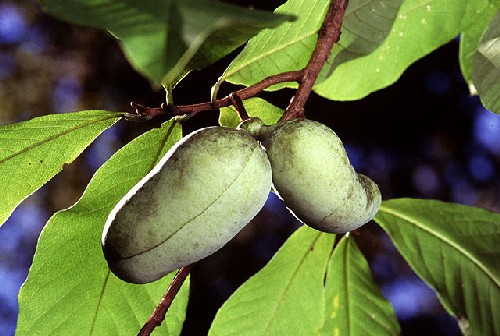What Is a Paw Paw?

What tastes like a cross between a banana and a mango and might be growing in your neighborhood right now?
If you're not sure, you probably don't know about the paw paw.
A little-known native of the eastern United States, paw paw fruit has yellow-green skin and soft, orange flesh with a creamy, custard-like consistency and a delicious, sweet flavor. [Science You Can Eat: 10 Things You Didn't Know About Food]
These qualities have earned it the nickname "custard apple," but it also goes by "poor man's banana" and "Indiana banana."
The paw paw tree (Asimina triloba) is indigenous to 26 states in the United States, growing wild from the Gulf Coast up to the Great Lakes region. It's a favorite host plant of the zebra swallowtail butterfly, whose larvae feed on the leaves.
Historically, the fruit was enjoyed by Native Americans and early European settlers alike. At least two U.S. presidents favored paw paws: George Washington reportedly enjoyed them for dessert, and Thomas Jefferson was known to have grown paw paws at Monticello.
Today the paw paw, which often grows along the banks of rivers and streams, is a convenient snack for kayakers and a staple in the autumn diets of many country dwellers.
Get the world’s most fascinating discoveries delivered straight to your inbox.
Paw paw aficionados eat the fruit straight from the tree, or use it in a variety of delicious recipes. Paw paw ice cream, anyone? How about paw paw-nut bread?
But despite this fruit's popularity with locals and its rich nutritional value (it's high in protein, antioxidants, vitamins A and C and several essential minerals), the pawpaw has managed to stay out of most grocery stores and off the radar of big agriculture.
The odd beanlike shape and mottled skin of the pawpaw make it a hard sell to consumers who don't know the custardy sweetness that lies beneath the fruit's exterior. And the pawpaw doesn't travel well: It bruises easily and has a short shelf life (two to three days at room temperature).
So if you want to give paw paws a try, don't run to the supermarket. Instead, look for this fruit at farmer's markets and specialty stores — including some online retailers — in the late summer or early autumn.
If you're a do-it-yourselfer, you can purchase your own pawpaw trees and start harvesting these fruits within a few years. As a native of the United States, it has few pests and doesn't need much care.
But be forewarned that the pawpaw's maroon blossom, while beautiful, is said to smell like rotting meat — which might further explain its delayed cultivation. (Bees and other insects show little interest in the pawpaw flower, so hand-pollination is sometimes required.)
Email asklizzyp@gmail.com or follow her @techEpalermo. Follow LiveScience on Twitter @livescience. We're also on Facebook & Google+.

